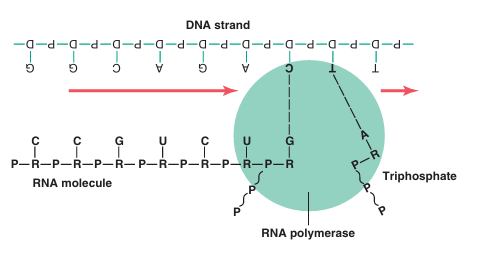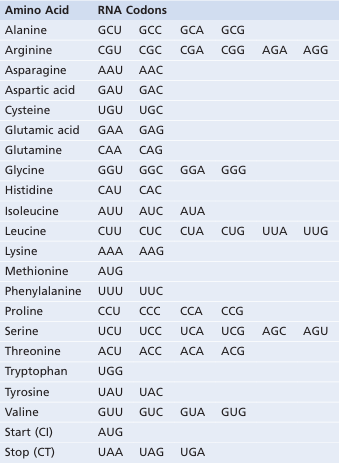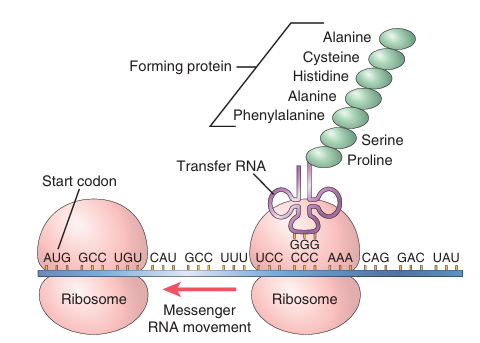There Are Several Different Types of RNA.
As research on RNA has continued to advance, many different types of RNA have been discovered. Some types of RNA are involved in protein synthesis, whereas other types serve gene regulatory functions or are involved in post transcriptional modification of RNA. The functions of some types of RNA, especially those that do not appear to code for proteins, are still mysterious. The following six types of RNA play independent and different roles in protein synthesis:
1. Precursor messenger RNA (pre-mRNA) is a large immature single strand of RNA that is processed in the nucleus to form mature messenger RNA (mRNA). The pre-RNA includes two different types of segments called introns, which are removed by a process called splicing, and exons, which are retained in the final mRNA.
2. Small nuclear RNA (snRNA) directs the splicing of pre-mRNA to form mRNA.
3. Messenger RNA (mRNA) carries the genetic code to the cytoplasm for controlling the type of protein formed.
4. Transfer RNA (tRNA) transports activated amino acids to the ribosomes to be used in assembling the protein molecule.
5. Ribosomal RNA, along with about 75 different proteins, forms ribosomes, the physical and chemical structures on which protein molecules are actually assembled.
6. MicroRNA (miRNA) are single-stranded RNA molecules of 21 to 23 nucleotides that can regulate gene transcription and translation.
MESSENGER RNA—THE CODONS
Messenger RNA molecules are long, single RNA strands that are suspended in the cytoplasm. These molecules are composed of several hundred to several thousand RNA nucleotides in unpaired strands, and they contain codons that are exactly complementary to the code triplets of the DNA genes. (Figure1) shows a small segment of mRNA. Its codons are CCG, UCU, and GAA, which are the codons for the amino acids proline, serine, and glutamic acid. The transcription of these codons from the DNA molecule to the RNA molecule is shown in (Figure 2).

fig1. A portion of an RNA molecule showing three RNA codons—CCG, UCU, and GAA—that control attachment of the three amino acids, proline, serine, and glutamic acid, respectively, to the growing RNA chain

fig2. Combination of ribose nucleotides with a strand of DNA to form a molecule of RNA that carries the genetic code from the gene to the cytoplasm. The RNA polymerase enzyme moves along the DNA strand and builds the RNA molecule.
RNA Codons for the Different Amino Acids. (Table 1) lists the RNA codons for the 22 common amino acids found in protein molecules. Note that most of the amino acids are represented by more than one codon; also, one codon represents the signal “start manufacturing the protein molecule,” and three codons represent “stop manufacturing the protein molecule.” In (Table 1), these two types of codons are designated CI for “chain initiating” or “start” codon and CT for “chain-terminating” or “stop” codon

table1. RNA Codons for Amino Acids and for Start and Stop
TRANSFER RNA—THE ANTICODONS
Another type of RNA that plays an essential role in protein synthesis is called transfer RNA (tRNA) because it transfers amino acid molecules to protein molecules as the protein is being synthesized. Each type of tRNA combines specifically with 1 of the 20 amino acids that are to be incorporated into proteins. The tRNA then acts as a carrier to transport its specific type of amino acid to the ribosomes, where protein molecules are forming. In the ribosomes, each specific type of tRNA recognizes a particular codon on the mRNA (described later) and thereby delivers the appropriate amino acid to the appropriate place in the chain of the newly forming protein molecule.
Transfer RNA, which contains only about 80 nucleotides, is a relatively small molecule in comparison with mRNA. It is a folded chain of nucleotides with a cloverleaf appearance similar to that shown in (Figure 3). At one end of the molecule there is always an adenylic acid to which the transported amino acid attaches at a hydroxyl group of the ribose in the adenylic acid.

fig3. A messenger RNA strand is moving through two ribosomes . As each codon passes through, an amino acid is added to the growing protein chain, which is shown in the right-hand ribosome. The transfer RNA molecule transports each specific amino acid to the newly forming protein.
Because the function of tRNA is to cause attachment of a specific amino acid to a forming protein chain, it is essential that each type of tRNA also have specificity for a particular codon in the mRNA. The specific code in the tRNA that allows it to recognize a specific codon is again a triplet of nucleotide bases and is called an anticodon. This anticodon is located approximately in the middle of the tRNA molecule (at the bottom of the cloverleaf configuration shown in (Figure 3). During formation of the protein molecule, the anticodon bases combine loosely by hydrogen bonding with the codon bases of the mRNA. In this way, the respective amino acids are lined up one after another along the mRNA chain, thus establishing the appropriate sequence of amino acids in the newly forming protein molecule.
RIBOSOMAL RNA
The third type of RNA in the cell is ribosomal RNA, which constitutes about 60 percent of the ribosome. The remainder of the ribosome is protein, including about 75 types of proteins that are both structural proteins and enzymes needed in the manufacture of protein molecules.
The ribosome is the physical structure in the cytoplasm on which protein molecules are actually synthesized. However, it always functions in association with the other two types of RNA: tRNA transports amino acids to the ribosome for incorporation into the developing protein molecule, whereas mRNA provides the information necessary for sequencing the amino acids in proper order for each specific type of protein to be manufactured. Thus, the ribosome acts as a manufacturing plant in which the protein molecules are formed.
Formation of Ribosomes in the Nucleolus. The DNA genes for formation of ribosomal RNA are located in five pairs of chromosomes in the nucleus. Each of these chromosomes contains many duplicates of these particular genes because of the large amounts of ribosomal RNA required for cellular function.
As the ribosomal RNA forms, it collects in the nucleolus, a specialized structure lying adjacent to the chromosomes. When large amounts of ribosomal RNA are being synthesized, as occurs in cells that manufacture large amounts of protein, the nucleolus is a large structure, whereas in cells that synthesize little protein, the nucleolus may not even be seen. Ribosomal RNA is specially processed in the nucleolus, where it binds with “ribosomal proteins” to form granular condensation products that are primordial subunits of ribosomes. These subunits are then released from the nucleolus and transported through the large pores of the nuclear envelope to almost all parts of the cytoplasm. After the sub units enter the cytoplasm, they are assembled to form mature, functional ribosomes. Therefore, proteins are formed in the cytoplasm of the cell but not in the cell nucleus, because the nucleus does not contain mature ribosomes .
miRNA AND SMALL INTERFERING RNA
A fourth type of RNA in the cell is microRNA (miRNA). miRNA are short (21 to 23 nucleotides) single-stranded RNA fragments that regulate gene expression
The miRNAs are encoded from the transcribed DNA of genes, but they are not translated into protein and are therefore often called noncoding RNA. The miRNAs are processed by the cell into molecules that are complementary to mRNA and act to decrease gene expression. Generation of miRNAs involves special processing of longer primary precursor RNAs called pri miRNAs, which are the primary transcripts of the gene. The pri-miRNAs are then processed in the cell nucleus by the microprocessor complex to pre-miRNAs, which are 70-nucleotide stem-loop structures. These pre-miRNAs are then further processed in the cytoplasm by a specific dicer enzyme that helps assemble an RNA-induced silencing complex (RISC) and generates miRNAs.
The miRNAs regulate gene expression by binding to the complementary region of the RNA and promoting repression of translation or degradation of the mRNA before it can be translated by the ribosome. miRNAs are believed to play an important role in the normal regulation of cell function, and alterations in miRNA function have been associated with diseases such as cancer and heart disease.
Another type of miRNA is small interfering RNA (siRNA), also called silencing RNA or short interfering RNA. The siRNAs are short, double-stranded RNA molecules, 20 to 25 nucleotides in length, that interfere with the expression of specific genes. siRNAs generally refer to synthetic miRNAs and can be administered to silence expression of specific genes. They are designed to avoid the nuclear processing by the microprocessor complex, and after the siRNA enters the cytoplasm it activates the RISC silencing complex, blocking the translation of mRNA. Because siRNAs can be tailored for any specific sequence in the gene, they can be used to block translation of any mRNA and therefore expression by any gene for which the nucleotide sequence is known. Researchers have proposed that siRNAs may become useful therapeutic tools to silence genes that contribute to the pathophysiology of diseases.
 الاكثر قراءة في مواضيع عامة في الاحياء الجزيئي
الاكثر قراءة في مواضيع عامة في الاحياء الجزيئي
 اخر الاخبار
اخر الاخبار
اخبار العتبة العباسية المقدسة


